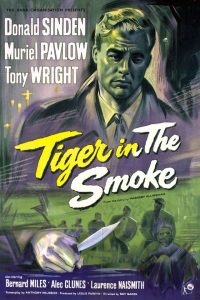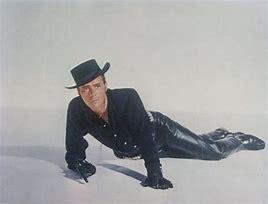Our discussion on The Singer Not the Song included: comments on its melodramatic characters and plot as well as the Western genre; the film’s camp sensibility; Bogarde’s screen and star images; information on the film’s production.
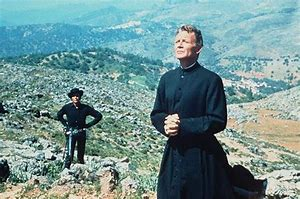 As with other Dirk Bogarde films we’ve screened this term, we commented on the characters and the plot in terms of melodrama. In The Singer Not the Song, these were especially tied to certain tropes of the Western. John Mills, as the newcomer Catholic priest Michael Keogh, enters a small Mexican town dressed entirely in black – he wears a long soutane and clerical hat. While this might signal in traditional Westerns that he is the villain, his vocation and polite interaction with Mylene Demongeot’s local young woman, Locha de Cortinez, instead point to him as a heroic figure.
As with other Dirk Bogarde films we’ve screened this term, we commented on the characters and the plot in terms of melodrama. In The Singer Not the Song, these were especially tied to certain tropes of the Western. John Mills, as the newcomer Catholic priest Michael Keogh, enters a small Mexican town dressed entirely in black – he wears a long soutane and clerical hat. While this might signal in traditional Westerns that he is the villain, his vocation and polite interaction with Mylene Demongeot’s local young woman, Locha de Cortinez, instead point to him as a heroic figure.  This is even more clearly delineated when Bogarde makes his first appearance as Anacleto Comachi. He too is clad entirely in black, but in tight leather trousers which, unlike the priests’ costume, leave very little to the imagination. There are also moments when Bogarde’s three-dimensional performance becomes less nuanced. We especially noted Anacleto calmly stroking a pure white cat, a sure-sign of villainous intent.
This is even more clearly delineated when Bogarde makes his first appearance as Anacleto Comachi. He too is clad entirely in black, but in tight leather trousers which, unlike the priests’ costume, leave very little to the imagination. There are also moments when Bogarde’s three-dimensional performance becomes less nuanced. We especially noted Anacleto calmly stroking a pure white cat, a sure-sign of villainous intent.
Anacleto calls for his associates to kill Father Keogh after the latter refuses to back down in the face of violence. The brakes on the priest’s car fail as he is being driven on treacherous mountain roads, with him and the driver only narrowly cheating death. Later on, when Father Keogh is exiting the church, he is saved from being injured by a machete by raising the heavy book he is holding. Father Keogh considers both his escapes to be miraculous and states that they were directed by God. The mountain was moved by faith which provided a new track on which the car could run, and the book which affords him protection at the church is the bible. While Father Keogh sees these as miraculous, such incredible escapes are not all that unusual in melodrama.
Father Keogh takes these attempts on his life in his stride, perhaps because, as he tells Anacleto, everyone must face suffering – especially priests. Such suffering is often at the heart of melodrama, especially in relation to women. Indeed, the film’s main female character, Locha, is bound by her gender and her class. Because she is privileged, she is kept safe and in comfort, but she has little to do. Her lack of mobility is starkly conveyed by her wish to learn to drive in order that she has some independence. Locha’s suffering, and inability to act on her desires, is increased when she falls in love with a man she cannot have.
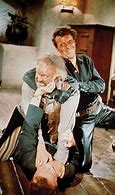 While Locha continues to be a one-dimensional and formulaic victim, the line between hero (Father Keogh) and villain (Anacleto) becomes increasingly blurred. The priest’s life is attempted for the third time, but Anacleto steps in to save him, at great personal cost. Anacleto’s associate, old Uncle (Laurence Naismith), has just abruptly left Anacleto to visit the priest. Anacleto soon follows, pausing only to collect a gun. In a confrontation at the priest’s house, the man who has been like a father to Anacleto accuses him of liking the priest so much he is turning against his old comrades. His view is substantiated when Anacleto shoots the old man dead to halt his attack on Father Keogh. The scene wraps up with the police chief (John Bentley) arresting Anacleto, and the criminal forced to leave town. While this vanquishing of the threat may seem to conclude the film – despite the fact it occurs just over an hour in to the narrative – at least half of its running time is left, ample space for the film to explore Anacleto’s complex motives.
While Locha continues to be a one-dimensional and formulaic victim, the line between hero (Father Keogh) and villain (Anacleto) becomes increasingly blurred. The priest’s life is attempted for the third time, but Anacleto steps in to save him, at great personal cost. Anacleto’s associate, old Uncle (Laurence Naismith), has just abruptly left Anacleto to visit the priest. Anacleto soon follows, pausing only to collect a gun. In a confrontation at the priest’s house, the man who has been like a father to Anacleto accuses him of liking the priest so much he is turning against his old comrades. His view is substantiated when Anacleto shoots the old man dead to halt his attack on Father Keogh. The scene wraps up with the police chief (John Bentley) arresting Anacleto, and the criminal forced to leave town. While this vanquishing of the threat may seem to conclude the film – despite the fact it occurs just over an hour in to the narrative – at least half of its running time is left, ample space for the film to explore Anacleto’s complex motives.
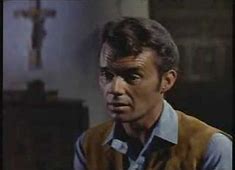 Anacleto returns to the town after about a year away. He continues to wear a similar costume, though there is some variation as the sombre black is relieved by a little colour – such as his yellow waistcoat. Anacleto directly appeals to Father Keogh for forgiveness. More importantly, Anacleto asks if he can move in with the priest so that the religious man can help the man without a God understand the purpose of faith. While the priest’s horror-stricken face suggests he is not amenable to Anacleto’s request, he allows him to stay in his spare room. From this position it becomes easier for Anacleto to influence both Father Keogh and Locha. He makes Locha doubt her decision to marry Phil from Florida, a man considered suitable by her parents. Anacleto correctly intuits that Locha is in love with the man who will perform the ceremony.
Anacleto returns to the town after about a year away. He continues to wear a similar costume, though there is some variation as the sombre black is relieved by a little colour – such as his yellow waistcoat. Anacleto directly appeals to Father Keogh for forgiveness. More importantly, Anacleto asks if he can move in with the priest so that the religious man can help the man without a God understand the purpose of faith. While the priest’s horror-stricken face suggests he is not amenable to Anacleto’s request, he allows him to stay in his spare room. From this position it becomes easier for Anacleto to influence both Father Keogh and Locha. He makes Locha doubt her decision to marry Phil from Florida, a man considered suitable by her parents. Anacleto correctly intuits that Locha is in love with the man who will perform the ceremony.
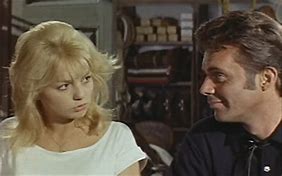 While Anacleto is right to attempt to come between Locha and Phil, his motives are unclear. Furthermore, his manipulation of her becomes more obvious. There is a level of performativity as Anacleto at first pretends to believe Locha’s mother’s assumption (which she shared with Father Keogh) that Locha is besotted with Anacleto. It is credible that this may be the case. Although he is a violent murderer, he is attractive and has a certain charm – indeed he is almost gentlemanly in his politeness. There also appears to be a suggestion of a previous friendship, or perhaps more, between the pair. Earlier in the film, Anacleto and Locha meet accidentally in a shop in the town. He says that she should be served first, and they appear to be on polite, if not quite friendly terms. Locha even reminds Anacleto that he once said that he would do anything to help her. He responds that this was said a long time ago, closing down the suggestion that changes his criminal ways.
While Anacleto is right to attempt to come between Locha and Phil, his motives are unclear. Furthermore, his manipulation of her becomes more obvious. There is a level of performativity as Anacleto at first pretends to believe Locha’s mother’s assumption (which she shared with Father Keogh) that Locha is besotted with Anacleto. It is credible that this may be the case. Although he is a violent murderer, he is attractive and has a certain charm – indeed he is almost gentlemanly in his politeness. There also appears to be a suggestion of a previous friendship, or perhaps more, between the pair. Earlier in the film, Anacleto and Locha meet accidentally in a shop in the town. He says that she should be served first, and they appear to be on polite, if not quite friendly terms. Locha even reminds Anacleto that he once said that he would do anything to help her. He responds that this was said a long time ago, closing down the suggestion that changes his criminal ways.
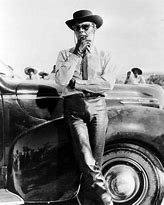 Anacleto’s ulterior motive in asking for Father Keogh’s spiritual guidance is also revealed. Initially Anacleto argued that the priest should not be killed since this would be a tactical error, him a martyr to the cause. Although Anacleto later agreed to two attempts on Father Keogh’s life because it appeared his intimidation was not working, he switched back to his earlier standpoint when old Uncle attacked the priest. His return to the town is therefore part of a very cunning plan to make Father Keogh doubt himself and his faith. Anacleto does not achieve this by undermining the priest’s religious beliefs (despite his questioning of the logic of these) but through Locha’s love for Father Keogh. By whisking Locha away before her wedding (which her father views as kidnap) Anacleto engineers for Locha and Father Keogh to meet at the criminals’ hideout. This leads to an awkward scene, at which Anacelto insists being present, as Locha and the priest share a forbidden kiss.
Anacleto’s ulterior motive in asking for Father Keogh’s spiritual guidance is also revealed. Initially Anacleto argued that the priest should not be killed since this would be a tactical error, him a martyr to the cause. Although Anacleto later agreed to two attempts on Father Keogh’s life because it appeared his intimidation was not working, he switched back to his earlier standpoint when old Uncle attacked the priest. His return to the town is therefore part of a very cunning plan to make Father Keogh doubt himself and his faith. Anacleto does not achieve this by undermining the priest’s religious beliefs (despite his questioning of the logic of these) but through Locha’s love for Father Keogh. By whisking Locha away before her wedding (which her father views as kidnap) Anacleto engineers for Locha and Father Keogh to meet at the criminals’ hideout. This leads to an awkward scene, at which Anacelto insists being present, as Locha and the priest share a forbidden kiss. 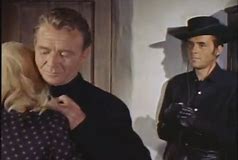 Father Keogh then gives Anacleto his word that if he frees Locha, he will tell the townspeople to support Anacleto. A set-piece at the church, in front of a full congregation, including Anacleto, shows Father Keogh breaking his promise. Anacleto accuses the priest of betraying him, and indeed Father Keogh seem more tormented by this than by his illicit romance with Locha.
Father Keogh then gives Anacleto his word that if he frees Locha, he will tell the townspeople to support Anacleto. A set-piece at the church, in front of a full congregation, including Anacleto, shows Father Keogh breaking his promise. Anacleto accuses the priest of betraying him, and indeed Father Keogh seem more tormented by this than by his illicit romance with Locha.
 Unsurprisingly, what Anacleto views as Father Keogh’s treachery does not go unpunished. The film ends in a Western-style shoot out. Although the priest does not brandish a weapon, he is caught in the cross-fire as he goes to the injured Anacleto’s aid. Father Keogh remains close to the injured man, urging him to confess his crimes. The two men become even closer physically when the priest is shot by one of Anacleto’s followers and he falls on top of the bandit, the two men lying together in death. The film has been leading up to this sexually charged, homoerotic moment due to its camp sensibility.
Unsurprisingly, what Anacleto views as Father Keogh’s treachery does not go unpunished. The film ends in a Western-style shoot out. Although the priest does not brandish a weapon, he is caught in the cross-fire as he goes to the injured Anacleto’s aid. Father Keogh remains close to the injured man, urging him to confess his crimes. The two men become even closer physically when the priest is shot by one of Anacleto’s followers and he falls on top of the bandit, the two men lying together in death. The film has been leading up to this sexually charged, homoerotic moment due to its camp sensibility.
This is perhaps most obvious in Anacleto’s costume. His tight-fitting trousers seem especially calculated to draw attention, in a bid to display himself as a sexual being. Anacleto’s deliberate physical posturing, his precise vocal delivery and his archly-raised eyebrows at key moments also contribute to the camp mood. Exaggeration is also evident in Anacleto’s role as dangerous bandit, as well as the fact that this calls for a certain performance – the townsfolk must believe in the threat in order to be frightened of it. Furthermore, this increases when Anacleto returns, supposedly seeking forgiveness, but in fact faking his contrition.
 In relation to performativity, it is significant that Anacleto’s only moment of heterosexual romance is strictly for show. Having been informed by Father Keogh of Locha’s supposed love for him, Anacleto, Anacleto attempts to kiss her. She rebuffs him, and he admits he only tried to embrace her in order to confirm his suspicion that she loves Father Keogh. Anacleto’s pushing together of Father Keogh and Locha is for his own purposes, rather than an endorsement of such relationships. The lack of heterosexual romance does not necessarily mean we must assume that a homosexual one is present, but the in addition to the film’s camp tone, some of the film’s dialogue supports such a reading. Anacleto tells Locha that ‘it must be heart-breaking to be in love with a man you can’t have’ and that he ‘understands’ it. This makes us view the film’s ending, with Anacleto and Father Keogh united in death, in a certain light. Any passion the two men may have for one another is deemed impossible.
In relation to performativity, it is significant that Anacleto’s only moment of heterosexual romance is strictly for show. Having been informed by Father Keogh of Locha’s supposed love for him, Anacleto, Anacleto attempts to kiss her. She rebuffs him, and he admits he only tried to embrace her in order to confirm his suspicion that she loves Father Keogh. Anacleto’s pushing together of Father Keogh and Locha is for his own purposes, rather than an endorsement of such relationships. The lack of heterosexual romance does not necessarily mean we must assume that a homosexual one is present, but the in addition to the film’s camp tone, some of the film’s dialogue supports such a reading. Anacleto tells Locha that ‘it must be heart-breaking to be in love with a man you can’t have’ and that he ‘understands’ it. This makes us view the film’s ending, with Anacleto and Father Keogh united in death, in a certain light. Any passion the two men may have for one another is deemed impossible.
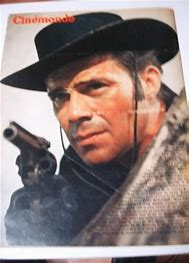 We also commented on the film in relation to Bogarde’s screen and star images. In between last time’s screening (Libel) and The Singer Not the Song, Bogarde appeared in two films, both in 1960: The Angel Wore Red (Nunnally Johnson) and Song Without End (Charles Vidor; George Cukor). The former’s status as an Italian-American co-production and the latter’s as a US film extend Libel’s US/UK co-production. Bogarde played international characters in both: a Spanish former Catholic priest and the Hungarian composer Franz Liszt. Bogarde’s Mexican bandit therefore expands his repertoire of characters of different nationalities. From the available contemporaneous fan magazine materials it certainly seems to be the case that The Singer Not the Song, and perhaps Bogarde, were more lauded in France than in the UK. The British Film Institute’s Collection of Dirk Bogarde magazines includes two from this period which cover the film, and Bogarde, extensively: Cinemonde (11 April 1961) and Cine Tele Revue (15 September 1961). (You can read more on my cataloguing of the BFI’s Dirk Bogarde collection here: www.normmanetwork.com/) This prefigures Bogarde’s European films in the late 1960s, as well as his own move to France around the same time.
We also commented on the film in relation to Bogarde’s screen and star images. In between last time’s screening (Libel) and The Singer Not the Song, Bogarde appeared in two films, both in 1960: The Angel Wore Red (Nunnally Johnson) and Song Without End (Charles Vidor; George Cukor). The former’s status as an Italian-American co-production and the latter’s as a US film extend Libel’s US/UK co-production. Bogarde played international characters in both: a Spanish former Catholic priest and the Hungarian composer Franz Liszt. Bogarde’s Mexican bandit therefore expands his repertoire of characters of different nationalities. From the available contemporaneous fan magazine materials it certainly seems to be the case that The Singer Not the Song, and perhaps Bogarde, were more lauded in France than in the UK. The British Film Institute’s Collection of Dirk Bogarde magazines includes two from this period which cover the film, and Bogarde, extensively: Cinemonde (11 April 1961) and Cine Tele Revue (15 September 1961). (You can read more on my cataloguing of the BFI’s Dirk Bogarde collection here: www.normmanetwork.com/) This prefigures Bogarde’s European films in the late 1960s, as well as his own move to France around the same time.
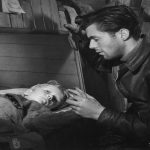 In addition to the international appeal of Bogarde, The Singer Not the Song builds on the ambiguity of Bogarde’s screen image since Anacleto, at least for some of the film, appears to have crossed from the bad to the good side. We’ve noticed throughout the term how Bogarde was able to be both hero and villain. The rogue Bogarde played in Esther Waters did not deliberately forsake the heroine, while in Hunted his killer-on-the-run sensitively cared for a small boy. In Libel Bogarde essayed two characters: one who attempts to kill the other, with the issue of lost memory meaning that the surviving man remains is unsure of his identity.
In addition to the international appeal of Bogarde, The Singer Not the Song builds on the ambiguity of Bogarde’s screen image since Anacleto, at least for some of the film, appears to have crossed from the bad to the good side. We’ve noticed throughout the term how Bogarde was able to be both hero and villain. The rogue Bogarde played in Esther Waters did not deliberately forsake the heroine, while in Hunted his killer-on-the-run sensitively cared for a small boy. In Libel Bogarde essayed two characters: one who attempts to kill the other, with the issue of lost memory meaning that the surviving man remains is unsure of his identity.
 More specifically, The Singer Not the Song expands on Libel’s gay, but especially, camp sensibilities. The Singer Not the Song’s contemporaneous reception shows that the interpretation of it being about passion between Anacleto and Father Keogh is not just a modern reading-in. In the November 1961 issue of the UK’s Films and Filming, well-known film reviewer and commentator Raymond Durgnat says as much, though within the context of society’s reticence on the subject. While this was not necessarily a widely-held view (i.e. the opinion of most filmgoers), it is worth considering how it might relate to Bogarde’s next film, Victim. The title of Basil Dearden’s ground-breaking film about a married gay barrister (Bogarde) points to its sympathetic attitude: at a time when sex between men was criminalised in the UK, it does not view its protagonist as a perpetrator. Victim was released six months after The Singer Not the Song. It is interesting to debate whether at the time, and indeed now, we may see Roy Ward Baker’s film as continuation of the gay and camp themes of Libel, or a retrograde step (with stereotyped characters and the deaths of both men) before Victim’s sensitive handling of the matter.
More specifically, The Singer Not the Song expands on Libel’s gay, but especially, camp sensibilities. The Singer Not the Song’s contemporaneous reception shows that the interpretation of it being about passion between Anacleto and Father Keogh is not just a modern reading-in. In the November 1961 issue of the UK’s Films and Filming, well-known film reviewer and commentator Raymond Durgnat says as much, though within the context of society’s reticence on the subject. While this was not necessarily a widely-held view (i.e. the opinion of most filmgoers), it is worth considering how it might relate to Bogarde’s next film, Victim. The title of Basil Dearden’s ground-breaking film about a married gay barrister (Bogarde) points to its sympathetic attitude: at a time when sex between men was criminalised in the UK, it does not view its protagonist as a perpetrator. Victim was released six months after The Singer Not the Song. It is interesting to debate whether at the time, and indeed now, we may see Roy Ward Baker’s film as continuation of the gay and camp themes of Libel, or a retrograde step (with stereotyped characters and the deaths of both men) before Victim’s sensitive handling of the matter.
It is difficult to know how much of a performance originates from an actor, and how much is already present in the script, or is prompted by the director or the editing. Additional information we can take into account is Bogarde’s relationship to The Singer Not the Song and Victim. While Bogarde fought for the role in Victim, he only undertook the role in The Singer Not the Song under sufferance as his last film under contact with Rank. Director/producer Roy Ward Baker was apparently also not keen on the project. Both aspects are documented in a newspaper article present in the BFI’s Dirk Bogarde collection (though not available on the official website). Matthew Sweet’s interview with Roy Ward Baker appeared in the Independent Review on the 7th of February 2003. Bogarde especially disagreed with the casting of Mills as the priest, being of the opinion that the man Locha falls for should be played by a younger actor.
 Specifically, in terms of how this affected Bogarde’s performance, Bogarde himself claimed he ‘did the whole thing for camp’ (in an interview with Bogarde in Brian McFarlane’s fascinating 1997 An Autobiography of British Cinema, p. 70, reworked from his 1992 Sixty Voices: Celebrities Recall the Golden Age of British Cinema). In Derek Collett’s 2015 biography of The Singer Not the Song’s screenwriter, Nigel Balchin, he goes as far as to attribute the most visible signal of the film’s camp sensibility – Anacleto’s leather trousers – to Bogarde. In His Own Executioner, Collett details that Bogarde obtained them from a tailor in Rome. Such production insights help us to further frame the film, and Bogarde’s screen and star images, especially in relation to camp. This is in addition to sources like Bogarde’s own memoirs, other people’s autobiographies, works on directors and films and the fantastic British Entertainment History Project. Running for more than 30 years, this includes more than 700 audio and video interviews with those working in film, television, theatre and radio: https://historyproject.org.uk/
Specifically, in terms of how this affected Bogarde’s performance, Bogarde himself claimed he ‘did the whole thing for camp’ (in an interview with Bogarde in Brian McFarlane’s fascinating 1997 An Autobiography of British Cinema, p. 70, reworked from his 1992 Sixty Voices: Celebrities Recall the Golden Age of British Cinema). In Derek Collett’s 2015 biography of The Singer Not the Song’s screenwriter, Nigel Balchin, he goes as far as to attribute the most visible signal of the film’s camp sensibility – Anacleto’s leather trousers – to Bogarde. In His Own Executioner, Collett details that Bogarde obtained them from a tailor in Rome. Such production insights help us to further frame the film, and Bogarde’s screen and star images, especially in relation to camp. This is in addition to sources like Bogarde’s own memoirs, other people’s autobiographies, works on directors and films and the fantastic British Entertainment History Project. Running for more than 30 years, this includes more than 700 audio and video interviews with those working in film, television, theatre and radio: https://historyproject.org.uk/
As ever, do log in to comment, or email me on sp458@kent.ac.uk and let me know you’d like me to add your thoughts to the blog.

